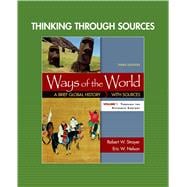
Note: Supplemental materials are not guaranteed with Rental or Used book purchases.
Purchase Benefits
What is included with this book?
Robert W. Strayer (Ph.D., University of Wisconsin) brings wide experience in world history to the writing of Ways of the World. His teaching career began in Ethiopia where he taught high school world history for two years as part of the Peace Corps. At the university level, he taught African, Soviet, and world history for many years at the State University of New York-College at Brockport, where he received Chancellor's Awards for Excellence in Teaching and for Excellence in Scholarship. In 1998 he was visiting professor of world and Soviet history at the University of Canterbury in Christchurch, New Zealand. Since moving to California in 2002, he has taught world history at the University of California, Santa Cruz; California State University, Monterey Bay; and Cabrillo College. He is a long-time member of the World History Association and served on its Executive Committee. He has also participated in various AP World History gatherings, including two years as a reader. His publications include Kenya: Focus on Nationalism, The Making of Mission Communities in East Africa, The Making of the Modern World, Why Did the Soviet Union Collapse?, and The Communist Experiment.
Eric W. Nelson (D.Phil., Oxford University) is a professor of history at Missouri State University. He is an experienced teacher who has won a number of awards, including the Governor’s Award for Teaching Excellence in 2011 and the CASE and Carnegie Foundation for the Advancement of Teaching Professor of the Year Award for Missouri in 2012. He is currently Faculty Fellow for Engaged Learning, developing new ways to integrate in-class and online teaching environments. His publications include The Legacy of Iconoclasm: Religious War and the Relic Landscape of Tours, Blois and Vendôme, and The Jesuits and the Monarchy: Catholic Reform and Political Authority in France.
The New copy of this book will include any supplemental materials advertised. Please check the title of the book to determine if it should include any access cards, study guides, lab manuals, CDs, etc.
The Used, Rental and eBook copies of this book are not guaranteed to include any supplemental materials. Typically, only the book itself is included. This is true even if the title states it includes any access cards, study guides, lab manuals, CDs, etc.